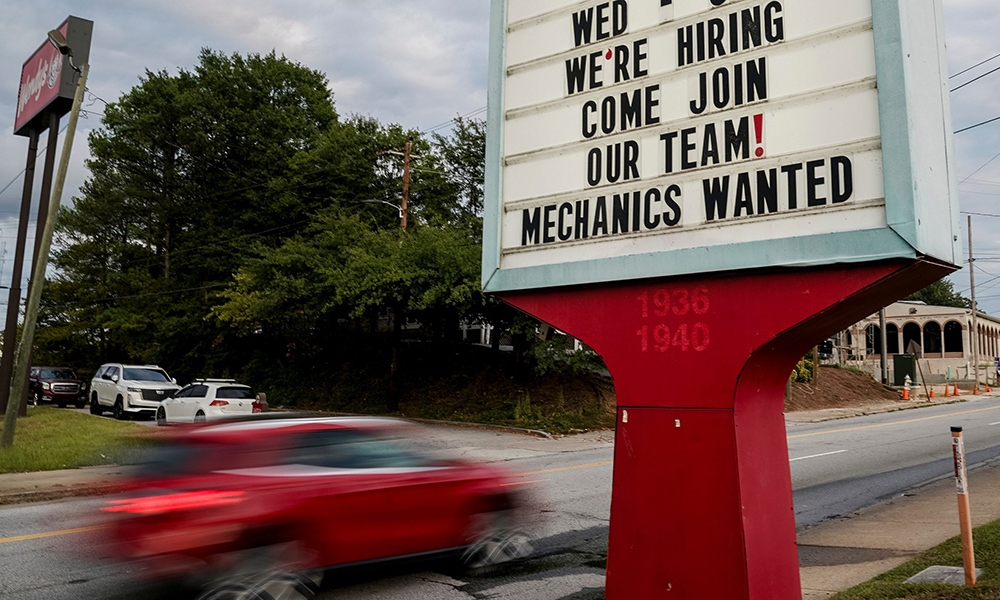
上周三,美聯(lián)儲自2020年3月以來首次降息。股市起初并不接受這一舉措,美國三大股指在震蕩交易后均收跌。
至關重要的是,雖然不能對單日股市波動進行過多解讀,但投資者對上周三股市劇烈波動的擔心主要有以下幾點。
首先,美聯(lián)儲決定大幅降息50個基點,而不是更常見的25個基點,這被一些人視為央行“落后于曲線”的證據(jù)——這意味著央行本應在幾個月前就降息以刺激經(jīng)濟。
其次,美聯(lián)儲對2025年底前降息的預期較為溫和,遠低于投資者對持續(xù)大幅降息的預期,這可能令一些市場參與者感到恐慌,他們擔心高利率會導致經(jīng)濟過快放緩。
然而,上周四,投資者的擔憂似乎得到了緩解。隨著初請失業(yè)金人數(shù)降至5月以來的最低水平,制造業(yè)調查顯示該行業(yè)的韌性強于預期,一項關鍵的薪資指標上升,美國經(jīng)濟看起來相對強勁。
亞德尼研究公司(Yardeni Research)首席市場策略師里克·沃勒斯坦(Eric Wallerstein)說,事實上,美聯(lián)儲看起來一點也不落后于曲線。
“如果美聯(lián)儲和市場因為歷史押著同樣的韻腳或重演而極度擔心失業(yè)問題……如果這是我們的主要擔憂。我們剛得到的數(shù)據(jù)顯示,實際上,制造業(yè)已經(jīng)在自行改善,失業(yè)率數(shù)據(jù)是自夏季以來最好的,美聯(lián)儲降息50個基點,我們正在實現(xiàn)某種形式的涅槃,對吧?”他告訴《財富》雜志。“美聯(lián)儲正在削弱我們多年來見過的最強經(jīng)濟體之一。”
三大跡象表明美國經(jīng)濟具有驚人的韌性
初請失業(yè)金人數(shù)
長期以來,投資者一直擔心持續(xù)的高利率會導致經(jīng)濟放緩,最終引發(fā)一連串的裁員潮。隨著申請失業(yè)救濟人數(shù)穩(wěn)步上升,他們一度有證據(jù)支持自己的理論。
但上周情況有所不同。截至9月14日當周初請失業(yè)金人數(shù)(衡量裁員的最佳指標之一)為21.9萬人。這是自5月份以來的最低水平,低于之前的23.1萬。
與此同時,失業(yè)人數(shù)縮減至6月初以來的水平。截至9月7日的當周,投保失業(yè)人數(shù),即積極領取失業(yè)救濟金的人數(shù),減少了1.4萬人,降至182.9萬人。
摩根士丹利(Morgan Stanley)E*TRADE和投資董事總經(jīng)理克里斯·拉金(Chris Larkin)通過電子郵件向《財富》雜志透露了上述數(shù)據(jù):“自‘大幅’降息以來的首個經(jīng)濟數(shù)據(jù),應該會讓美聯(lián)儲感到滿意。申請失業(yè)救濟金人數(shù)低于預期不會立即引發(fā)人們對勞動力市場過度放緩的擔憂。”
沃勒斯坦也贊同這一觀點。“每周初請失業(yè)金人數(shù)和續(xù)請失業(yè)救濟金人數(shù)都在下降……人們擔心失業(yè)率會繼續(xù)攀升。事實并非如此。裁員數(shù)據(jù)沒有顯示出經(jīng)濟放緩或衰退的跡象。”
制造業(yè)調查
多年來,美國經(jīng)濟的制造業(yè)一直在處理令人頭疼的問題,從疫情時期的供應鏈中斷到勞動力成本上升。由于該行業(yè)通常被視為衡量經(jīng)濟健康狀況的風向標,制造業(yè)的活動疲軟引發(fā)了一些人對美國經(jīng)濟增長持久性的擔憂。
不過,最近這些擔憂似乎再次有所緩和。上周四,費城聯(lián)邦儲備銀行制造業(yè)商業(yè)前景調查(衡量特拉華州、新澤西州南部、賓夕法尼亞州中部和東部制造業(yè)活動的指標)扭轉了夏季的下滑趨勢,轉為積極。
此前,紐約聯(lián)邦儲備銀行上周一公布的紐約帝國制造業(yè)指數(shù)顯示,該地區(qū)的商業(yè)活動在一年多以來首次出現(xiàn)增長。亞德尼研究公司的沃勒斯坦指出,對那些擔心經(jīng)濟疲軟或美聯(lián)儲落后于曲線的看跌投資者來說,多項制造業(yè)調查中的“活動改善”都是好跡象。
工資增長
在從2022年初9.3%的峰值持續(xù)下降到今年5月的3.1%之后,工資增長也可能最終出現(xiàn)轉機。Indeed的工資追蹤器(Wage Tracker)顯示,8月份公布的工資增長了3.3%,該公司稱這是“廣泛的”企穩(wěn)。
Indeed經(jīng)濟學家尼克·邦克(Nick Bunker)和艾莉森·施里瓦斯塔瓦(Allison Shrivastava)在評論該數(shù)據(jù)時寫道:“簡而言之,隨著公布的工資以與疫情前同樣穩(wěn)定和可持續(xù)的速度增長,Indeed工資追蹤器顯示,美國勞動力市場可能正步入正軌。”
亞德尼研究公司的沃勒斯坦再次指出,這一數(shù)據(jù)是經(jīng)濟增長的良好信號,誠然也有助于緩解投資者對勞動力市場惡化的擔憂。他說:“實際工資在上漲,跑贏了通脹,[消費者]也在進行消費。”
穩(wěn)定的工資增長、制造業(yè)的韌性以及缺乏裁員激增的證據(jù),都讓沃勒斯坦相信,市場可以繼續(xù)上漲,盡管會出現(xiàn)一些間歇性的波動。他表示:“只要經(jīng)濟增長強于預期,你就無需擔心。”(財富中文網(wǎng))
譯者:中慧言-王芳
上周三,美聯(lián)儲自2020年3月以來首次降息。股市起初并不接受這一舉措,美國三大股指在震蕩交易后均收跌。
至關重要的是,雖然不能對單日股市波動進行過多解讀,但投資者對上周三股市劇烈波動的擔心主要有以下幾點。
首先,美聯(lián)儲決定大幅降息50個基點,而不是更常見的25個基點,這被一些人視為央行“落后于曲線”的證據(jù)——這意味著央行本應在幾個月前就降息以刺激經(jīng)濟。
其次,美聯(lián)儲對2025年底前降息的預期較為溫和,遠低于投資者對持續(xù)大幅降息的預期,這可能令一些市場參與者感到恐慌,他們擔心高利率會導致經(jīng)濟過快放緩。
然而,上周四,投資者的擔憂似乎得到了緩解。隨著初請失業(yè)金人數(shù)降至5月以來的最低水平,制造業(yè)調查顯示該行業(yè)的韌性強于預期,一項關鍵的薪資指標上升,美國經(jīng)濟看起來相對強勁。
亞德尼研究公司(Yardeni Research)首席市場策略師里克·沃勒斯坦(Eric Wallerstein)說,事實上,美聯(lián)儲看起來一點也不落后于曲線。
“如果美聯(lián)儲和市場因為歷史押著同樣的韻腳或重演而極度擔心失業(yè)問題……如果這是我們的主要擔憂。我們剛得到的數(shù)據(jù)顯示,實際上,制造業(yè)已經(jīng)在自行改善,失業(yè)率數(shù)據(jù)是自夏季以來最好的,美聯(lián)儲降息50個基點,我們正在實現(xiàn)某種形式的涅槃,對吧?”他告訴《財富》雜志。“美聯(lián)儲正在削弱我們多年來見過的最強經(jīng)濟體之一。”
三大跡象表明美國經(jīng)濟具有驚人的韌性
初請失業(yè)金人數(shù)
長期以來,投資者一直擔心持續(xù)的高利率會導致經(jīng)濟放緩,最終引發(fā)一連串的裁員潮。隨著申請失業(yè)救濟人數(shù)穩(wěn)步上升,他們一度有證據(jù)支持自己的理論。
但上周情況有所不同。截至9月14日當周初請失業(yè)金人數(shù)(衡量裁員的最佳指標之一)為21.9萬人。這是自5月份以來的最低水平,低于之前的23.1萬。
與此同時,失業(yè)人數(shù)縮減至6月初以來的水平。截至9月7日的當周,投保失業(yè)人數(shù),即積極領取失業(yè)救濟金的人數(shù),減少了1.4萬人,降至182.9萬人。
摩根士丹利(Morgan Stanley)E*TRADE和投資董事總經(jīng)理克里斯·拉金(Chris Larkin)通過電子郵件向《財富》雜志透露了上述數(shù)據(jù):“自‘大幅’降息以來的首個經(jīng)濟數(shù)據(jù),應該會讓美聯(lián)儲感到滿意。申請失業(yè)救濟金人數(shù)低于預期不會立即引發(fā)人們對勞動力市場過度放緩的擔憂。”
沃勒斯坦也贊同這一觀點。“每周初請失業(yè)金人數(shù)和續(xù)請失業(yè)救濟金人數(shù)都在下降……人們擔心失業(yè)率會繼續(xù)攀升。事實并非如此。裁員數(shù)據(jù)沒有顯示出經(jīng)濟放緩或衰退的跡象。”
制造業(yè)調查
多年來,美國經(jīng)濟的制造業(yè)一直在處理令人頭疼的問題,從疫情時期的供應鏈中斷到勞動力成本上升。由于該行業(yè)通常被視為衡量經(jīng)濟健康狀況的風向標,制造業(yè)的活動疲軟引發(fā)了一些人對美國經(jīng)濟增長持久性的擔憂。
不過,最近這些擔憂似乎再次有所緩和。上周四,費城聯(lián)邦儲備銀行制造業(yè)商業(yè)前景調查(衡量特拉華州、新澤西州南部、賓夕法尼亞州中部和東部制造業(yè)活動的指標)扭轉了夏季的下滑趨勢,轉為積極。
此前,紐約聯(lián)邦儲備銀行上周一公布的紐約帝國制造業(yè)指數(shù)顯示,該地區(qū)的商業(yè)活動在一年多以來首次出現(xiàn)增長。亞德尼研究公司的沃勒斯坦指出,對那些擔心經(jīng)濟疲軟或美聯(lián)儲落后于曲線的看跌投資者來說,多項制造業(yè)調查中的“活動改善”都是好跡象。
工資增長
在從2022年初9.3%的峰值持續(xù)下降到今年5月的3.1%之后,工資增長也可能最終出現(xiàn)轉機。Indeed的工資追蹤器(Wage Tracker)顯示,8月份公布的工資增長了3.3%,該公司稱這是“廣泛的”企穩(wěn)。
Indeed經(jīng)濟學家尼克·邦克(Nick Bunker)和艾莉森·施里瓦斯塔瓦(Allison Shrivastava)在評論該數(shù)據(jù)時寫道:“簡而言之,隨著公布的工資以與疫情前同樣穩(wěn)定和可持續(xù)的速度增長,Indeed工資追蹤器顯示,美國勞動力市場可能正步入正軌。”
亞德尼研究公司的沃勒斯坦再次指出,這一數(shù)據(jù)是經(jīng)濟增長的良好信號,誠然也有助于緩解投資者對勞動力市場惡化的擔憂。他說:“實際工資在上漲,跑贏了通脹,[消費者]也在進行消費。”
穩(wěn)定的工資增長、制造業(yè)的韌性以及缺乏裁員激增的證據(jù),都讓沃勒斯坦相信,市場可以繼續(xù)上漲,盡管會出現(xiàn)一些間歇性的波動。他表示:“只要經(jīng)濟增長強于預期,你就無需擔心。"”(財富中文網(wǎng))
譯者:中慧言-王芳
The Federal Reserve cut interest rates for the first time since March 2020 on Wednesday. Stocks balked at the move initially, with all three major U.S. market indices ending the day in the red after a volatile trading session.
While it’s important not to read too far into single-day stock market gyrations, there were a few key investor fears blamed for Wednesday’s wild ride.
First, the Fed’s decision to opt for an outsized 50 basis point rate cut, instead of the more common 25 basis points, was seen by some as evidence that the central bank is “behind the curve”—meaning it should have cut rates months ago to stimulate the economy.
Second, the Fed’s more modest projections for interest rate cuts through the end of 2025—which were well below investors’ expectations for ongoing, aggressive cuts—may have spooked some market participants who fear high rates are slowing the economy too quickly.
On Thursday, however, investors’ fears seemed to have been assuaged. With initial jobless claims falling to their lowest level since May, manufacturing surveys demonstrating more resilience in that sector than anticipated, and a key wage tracker rising, the economy is looking relatively robust.
In fact, the Fed doesn’t look behind the curve at all, according to Eric Wallerstein, chief markets strategist at Yardeni Research.
“If the Fed and the market are extremely worried about unemployment because history rhymes or repeats…if that’s our main worry. And then we got data this morning showing, actually, the manufacturing sector is already improving on its own, unemployment data is the best since before the summer, and the Fed cut 50 basis points, you’re getting a kind of Nirvana, right?” he told Fortune. “The Fed is cutting into one of the stronger economies we’ve seen in years”
3 signs of a surprisingly resilient U.S. economy
Initial jobless claims
Investors have long feared that a sustained period of elevated interest rates will slow the economy, and eventually spark a string of layoffs. And for a time, they had some evidence to back their theory, with jobless claims steadily rising.
But this week was different. Initial jobless claims, one of the best measures of layoffs, came in at 219,000 for the week ending September 14. That’s the lowest level since May, and down from 231,000 the prior week.
Meanwhile, unemployment rolls shrunk to levels last seen in early June. Insured unemployment, or the number of people actively receiving unemployment benefits, dropped 14,000 to 1,829,000 for the week ending September 7.
“The first economic data point since the ‘jumbo’ rate cut should please the Fed,” Chris Larkin, managing director of trading and investing at E*TRADE from Morgan Stanley, told Fortune of the data via email. “Lower-than-expected jobless claims won’t raise any immediate concerns about the labor market slowing too much.”
Wallerstein echoed that view. “Initial weekly [jobless] claims and continuing [jobless] claims now are falling…people were worried the climb would continue. That’s not the case. There’s no slow down, recession evidence in the layoff data.”
Manufacturing surveys
The manufacturing sector of the U.S. economy has dealt with headaches for years, from COVID-era supply chain disruptions to rising labor costs. With the sector often seen as a gauge of the economy’s health, weak activity has led to some concerns about the durability of U.S. economic growth.
But, once again, those fears seem to have been tempered of late. On Thursday, the Philadelphia Federal Reserve Manufacturing Business Outlook Survey—a gauge of activity in the manufacturing sector in Delaware, southern New Jersey and central and eastern Pennsylvania—turned positive, bucking its summer downtrend.
This comes after the New York Federal Reserve’s Empire State Manufacturing Survey showed business activity growth in that region for the first time in more than a year on Monday. Yardeni Research’s Wallerstein noted this “improving activity” in multiple manufacturing surveys is a good sign for any bearish investors that were concerned about economic weakness, or the Fed being behind the curve.
Wage growth
After falling consistently from a peak of 9.3% at the start of 2022 to just 3.1% in May of this year, wage growth may also finally be turning the corner. Indeed’s Wage Tracker shows posted wages rose 3.3% in August in what the company labeled a “broad-based” stabilization.
“In short, with posted wages growing at the same steady and sustainable pace we saw before the pandemic, the Indeed Wage Tracker is signaling the U.S. labor market may be settling into a groove,” Indeed economists Nick Bunker and Allison Shrivastava wrote of the data.
Yardeni’s Research’s Wallerstein argued, once again, this data is a good sign for economic growth, and certainly helps assuage investor fears about a deteriorating labor market. “Real wages are rising, beating inflation, and [consumers] are spending,” he said.
Steady wage growth, manufacturing resilience and the lack of evidence of a layoff spike all give Wallerstein confidence that markets can continue their rise, with some intermittent volatility. “As long as the economy is growing stronger than expected, you don’t need to worry,” he said.






